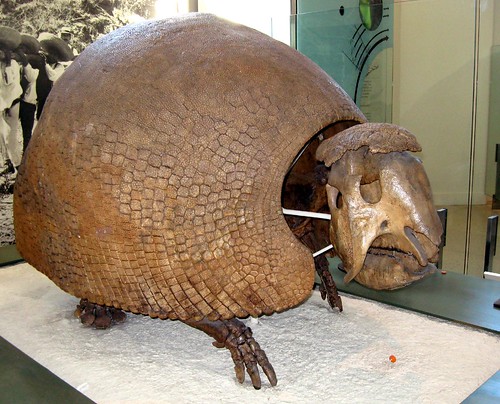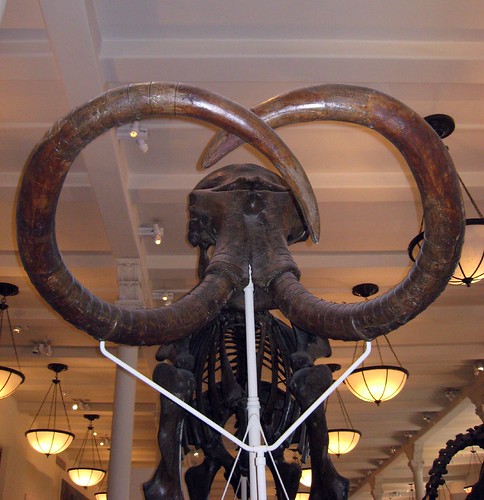With a hat tip to Brian's awesome Simpsons referencing title your correspondent humbly offers some further thoughts on Pleistocene rewilding. By way of introduction according to wikipedia:
''Pleistocene Rewilding promotes the reintroduction of descendants of Pleistocene megafauna and/or the closest extant ecological equivalents for those large mammals that went extinct during the Pleistocene. This proposal assumes that communities today are ecologically similar to communities in the Pleistocene and thus that introducing megafauna that are functionally similar to those that went extinct 13,000 years ago would promote biodiversity. Pleistocene rewilding is an extension of the conservation practice rewilding which involves reintroducing species to areas they went extinct from in recent history (hundreds of years ago) (Rubenstein et al. 2006). The fact that Pleistocene rewilding is based on ecosystems that evolved 13,000 years ago makes it very different from and much more controversial than rewilding."'
So for those of you wondering when the Pleistocene was we're talking about 1.8 million to 10,000 years ago and for our purposes the last few thousand years of that time period. If you're wondering what megafaua the Pleistocene had think Mammoths, Mastodon, Camels, Horses, Bison, Lions and Cheetah. Less familiar may be sabre-tooth cats, glyptodonts, giant ground sloths, short-faced bears and so forth (the clickable names will take you to wonderful reconstructions of the various species by Carl Buell). In fact some 70 odd species weighing over 100lb disappeared from North America around 13,000 years ago. Our ability to bring these species back ranges from simplish (Bolson's tortoise survives in parts of mexico and is being reintroduced already) through semi-complicated (modern lions are the same species as the extinct American lion, Jaguar are still sighted occasionally in the USA but with both being large Panthera sp and therefore, you know, capable of hunting, killing and eating humans aren't the best reintroduction candidates for a skeptical public) through very complicated (you've probably seen the Discovery Channel shows about Mammoths - we might be able to rebuild them) to absolutely done for (Glyptodonts, Giant beaver and Ground Sloths anyone?).
The logic behind Pleistocene rewilding is that whilst piecemeal reintroductions (such as those of captive bred Bolson's tortoises or Aplomado Falcons) are ok, to truly make the ecosystem work again it is necessary to reinsert all the missing working pieces or facsimiles thereof. By way of example Yellowstone with its wolves back is a very different place to Yellowstone without because the wolves influence behaviour of herbivores and so affect the herbivores' impact on plants which affects the whole landscape (Donlan has referred to this as the need for a "landscape of fear"). Similarly missing mammoths are important in how they no longer browse vegetation - we can see this in modern Africa where ivory poaching reduced the number of elephants which caused thicker scrub which reduced the number of cheetah which couldn't hunt effectively therein. In fact you can see shadows of these missing mammoths whenever you look at massively armed american tree species like locust (Robinia pseudoacacia).
So I think the idea that modern ecosystems are flawed as a result of a pleistocene die-off works. Does the proposed solution?
Well sort of. Lets be clear - it is easy to poke holes at the concept, holes like:
- we can't restore everything, some animals have no modern analogue;
- how do we know we're correctly identifying the right modern analogue?
- it could be a huge risk inserting exotic species; invasive non-natives can cause huge environmental damage;
- lions, elephants and other suggested introductions are, like, dangerous and stuff;
- it won't be "really wild" if we have to fence it and intervene; and
- how do we even know its working?
And yet. There is something about this idea that takes hold in the mind of a naturalist. Something that suggests pronghorn without cheetahs aren't wild, aren't pushed. Something that suggests that, even if just in a fenced off ranch, man shouldn't be the only influence on landscape. Something that says we should fix what our ancient ancestors broke.
I think both the "faults" against and emotional "motivations" in favour of Pleistocene rewilding above are kind of wrong. What is gone can in all likelihood never be restored, at least not by the hand of man. Nonetheless there is every reason to suspect that a Pleistocene rewilded area in North America would function somewhat better than the same area would if not rewilded and there is only one way to find out. Wicken Fen (one of the world's oldest nature reserves) uses a herd of Konik ponies to maintain the status quo of its vegetation. They are not native, not quite right for the region but they do the job perfectly.....and that is how we should view the "Pleistocene analogues" as living tools to help reshape a damaged landscape closer to how it should look. Its not perfect but its one of the best schemes we've got and if there's a billionaire American rancher reading this and looking for a fun project I say lets roll the dice and see what comes up.
Meanwhile in Russia Sergey Zimov is creating a similar ranch for an animal that may never arrive. Pleistocene Park will (hopefully) repopulate an area of Russian wilderness with Saiga antelope, Wood bison, Musk oxen, Siberian Tiger and Amur leopard....oh and hopefully mammoth. Without successful cloning the keystone species will never turn up; its too cold for any living elephant and it will probably remain a dream. But whilst we're dreaming lets dream perfect....then lets wake up and try to achieve something close to perfect.
Further reading.
This was of necessity a somewhat superficial look at a rather complicated idea. I hope you found it interesting enough to maybe read some of the links below and leave your love it/hate it thoughts in the comments.
Shifting Baselines blog (feat. Josh Donlan)
Search Magazine on PW
original Nature PW proposal
American Naturalist paper on PW



1 comment:
A very interesting topic. Thanks for the overview and the links.
Post a Comment